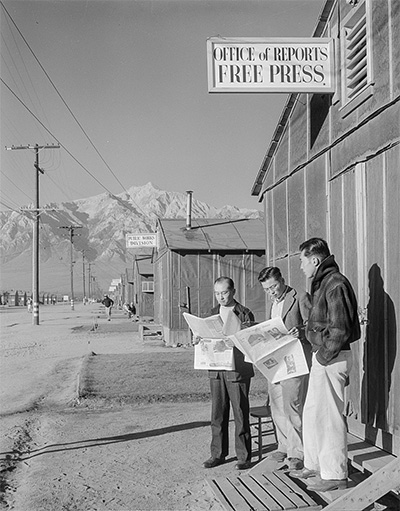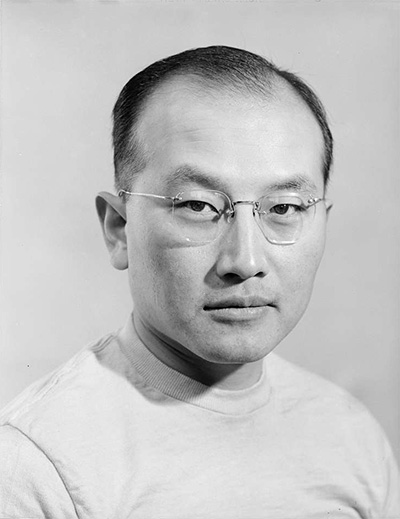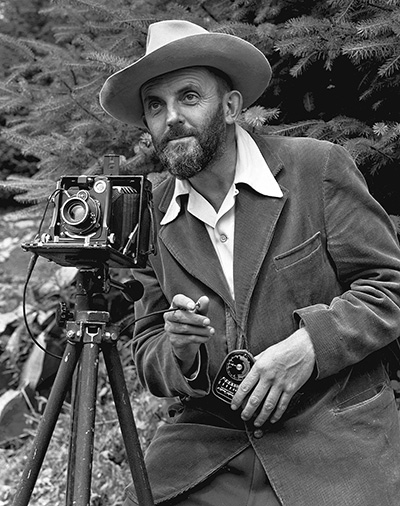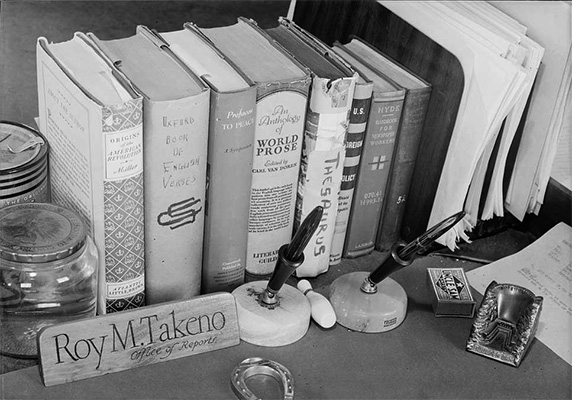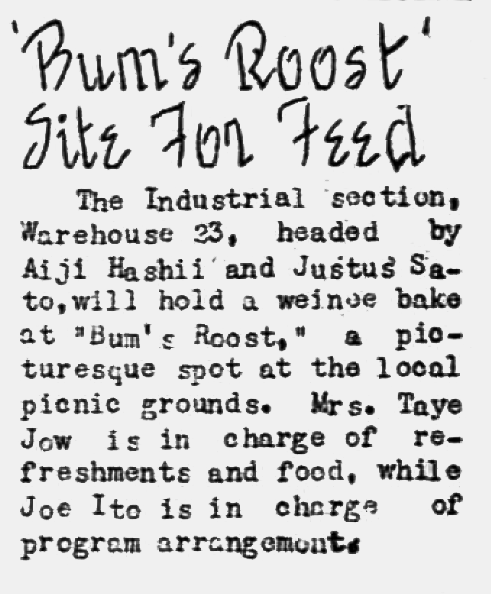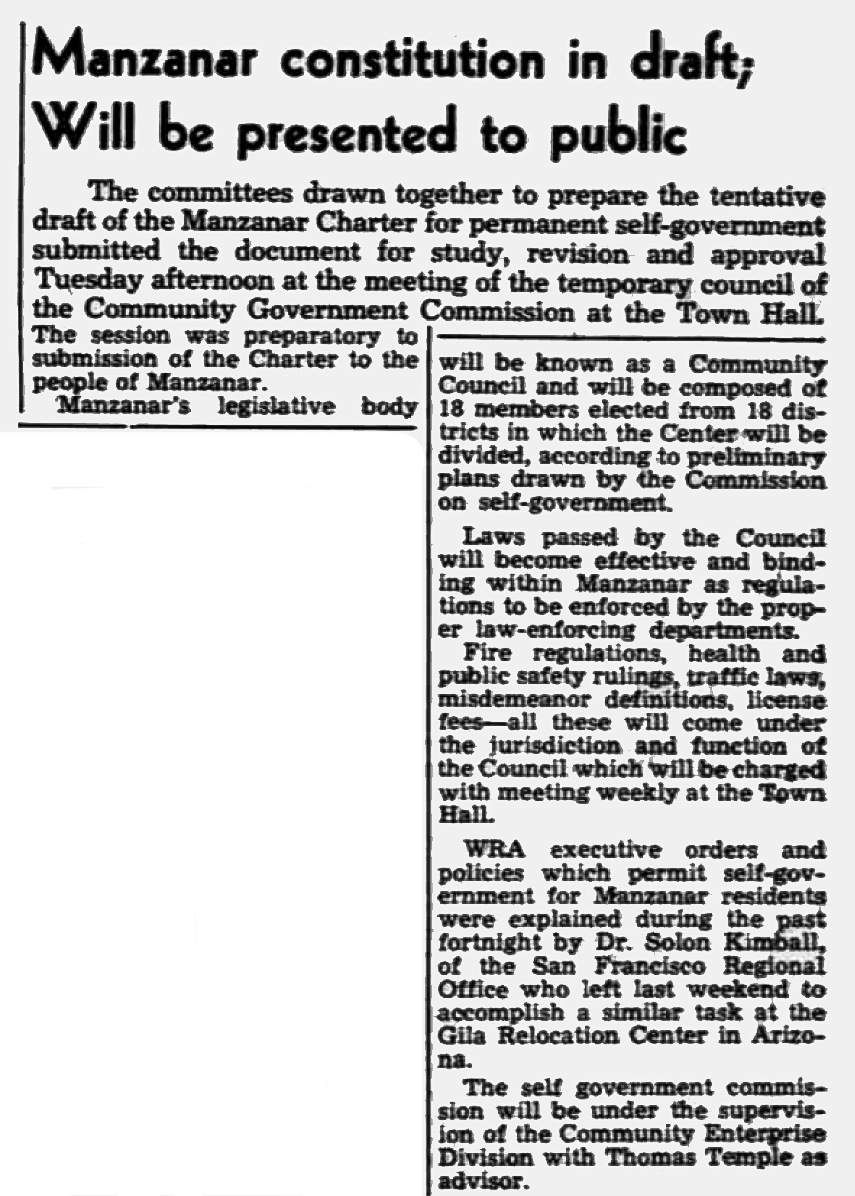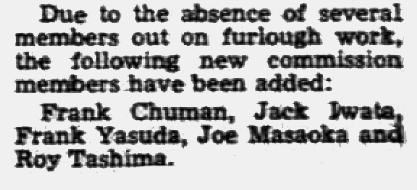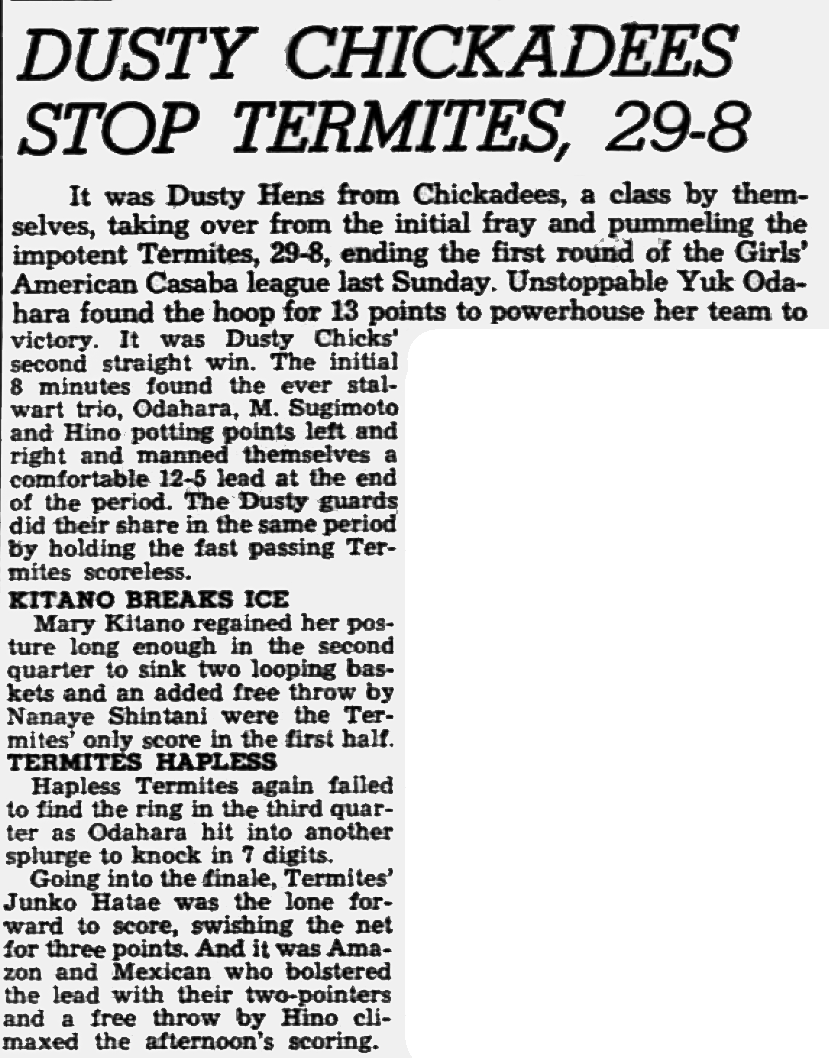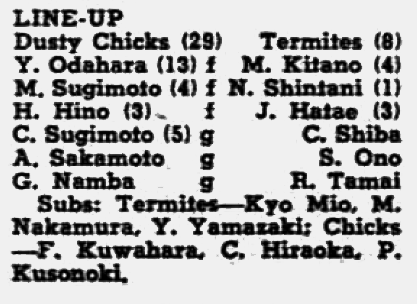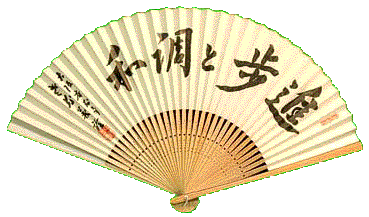
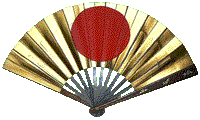
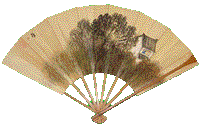

































































































|

See USE NOTICE on Home Page. |
|
All Manzanar Free Press articles, photos, and advertisements from issues located in the U. S. Library of Congress archives. |
Manzanar Free Press Complete Issues from the Manzanar National Historic Site 
|

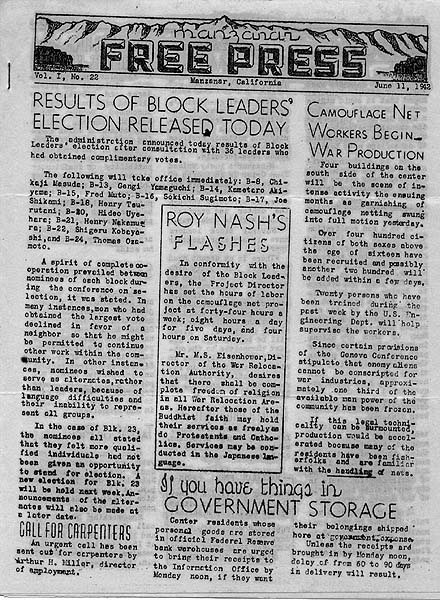
The Changing Faces of the Manzanar Free Press |
 |
 |
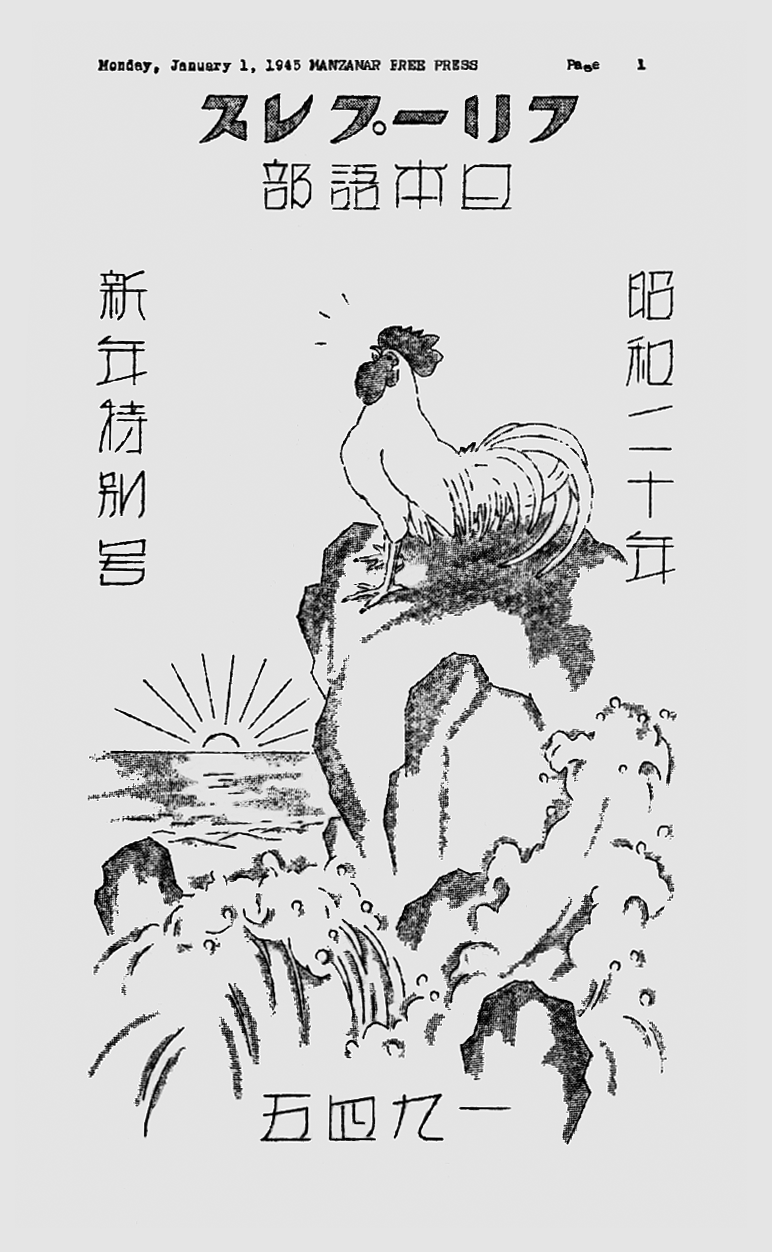 |
 |
 |
 |
 |
 |
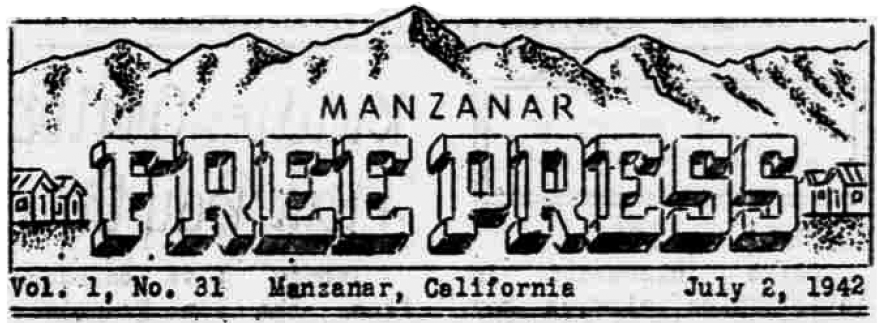 |
 |
 |
 |
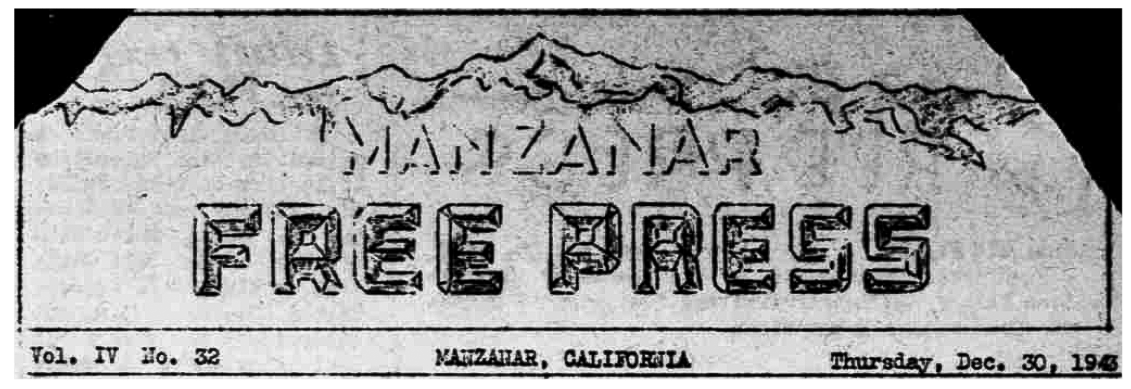 |
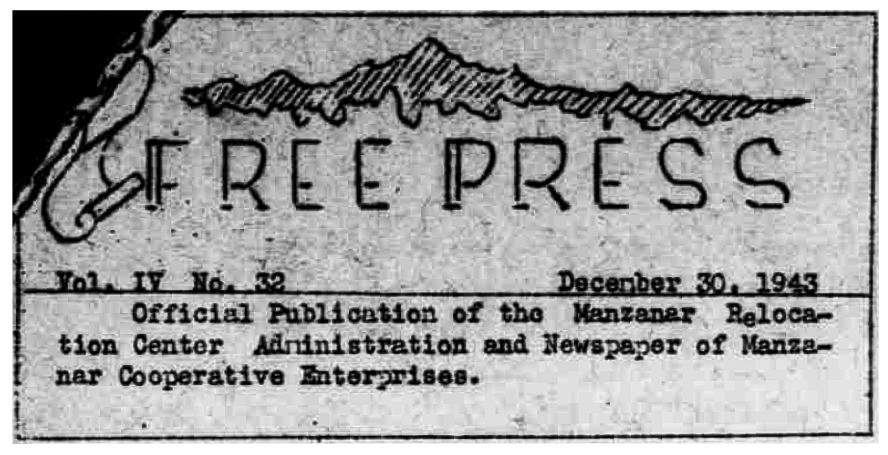 |
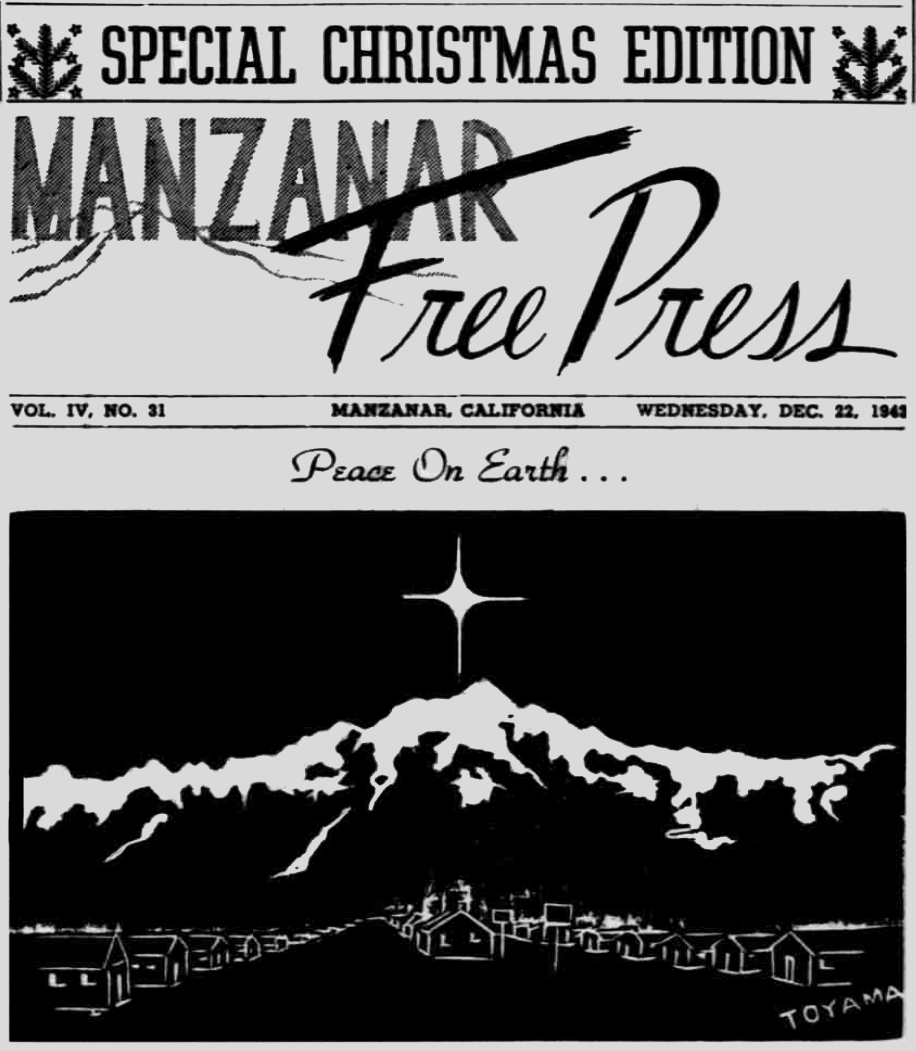 |
 |
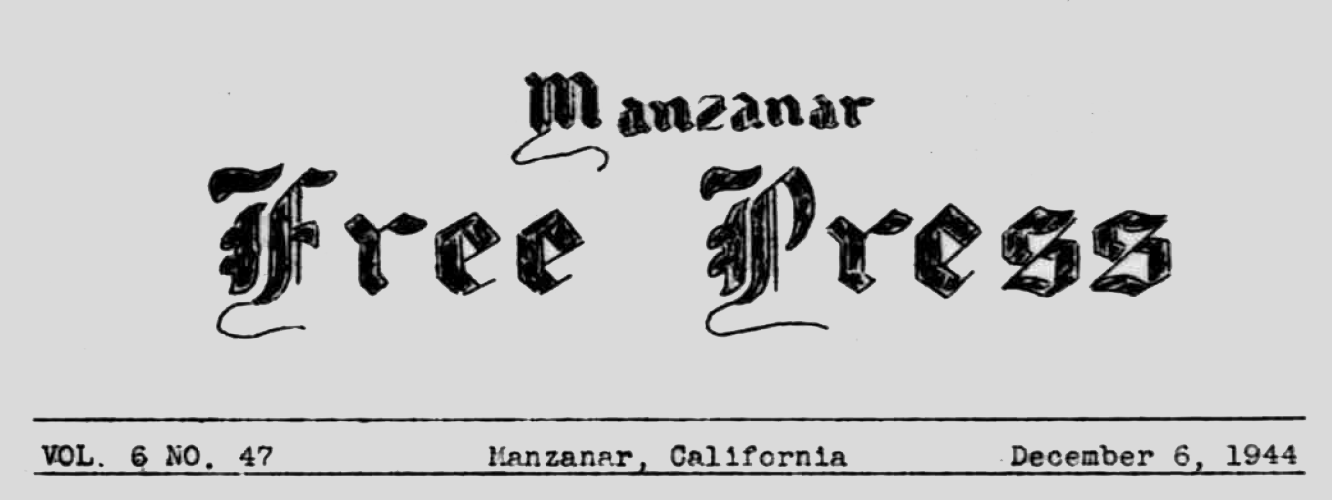 |
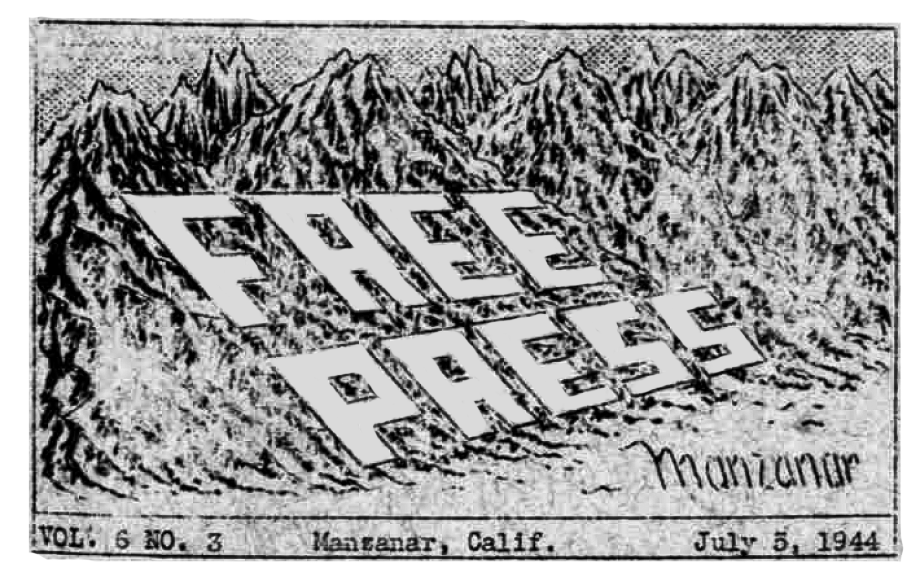 |
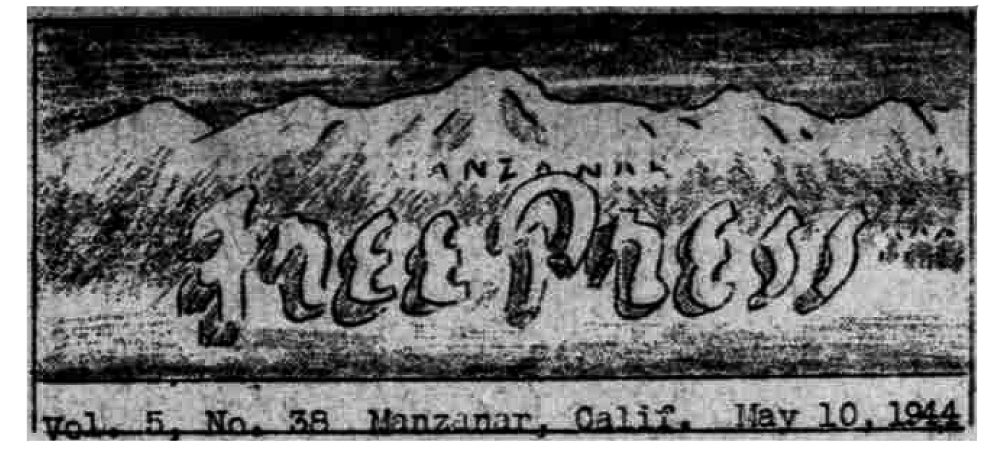 |
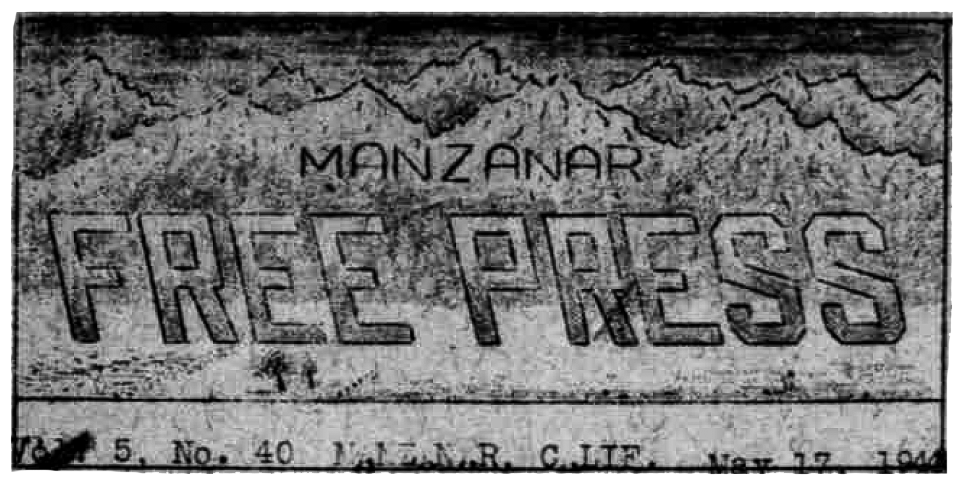 |
 |
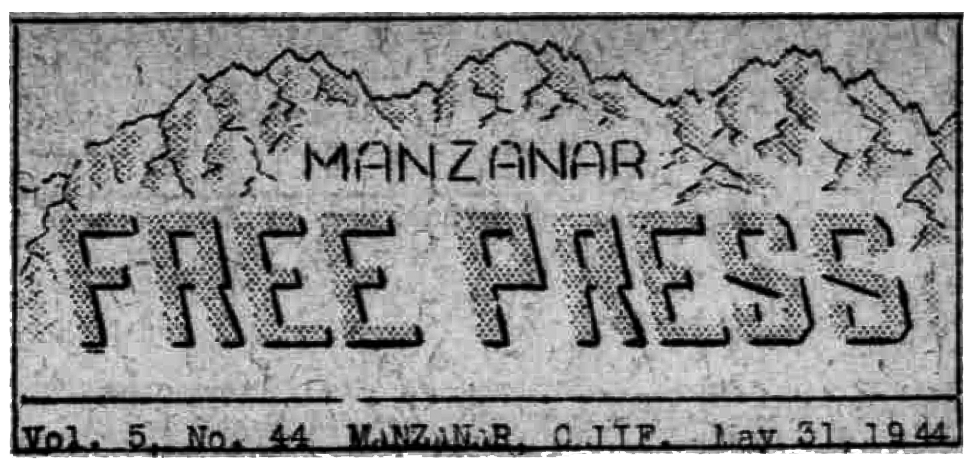 |
 |
| David Kinbrough writes: I was searching for something at the Library of Congress, and I got a hit I had never seen before. It was a copy of the “Manzanar Free Press,” a newspaper published by internees at the Manzanar War Relocation Center in Inyo County. Manzanar is the Spanish word for an apple orchard. It is the site in the Owen’s Valley where the United States Army built a concentration camp for Japanese Americans during WW II. There was a whole chain of these camps across the western United States where over 100,000 Japanese Americans were locked up for most of the war. I knew a newspaper had been published there with the pretty cheeky name of “Free Press” since none of the internees who published and read the paper were free, and the War Department censored the newspaper. However, I did not know that this newspaper had been digitized and made available on the Library of Congress webpage. I poked around a bit and found a lot of fascinating stories. Most of the stories were about things like being jailed unjustly because of political expediency and pandering to racism, all of the practical issues of living in an arid, windswept, scorpion invested wasteland in hastily and poorly constructed buildings, and how the hell to get out (work in a beet processing plant in Idaho was one way). Other stories were more mundane, how to address the shortage of shoyu (they ended building their own shoyu factory), how to get confiscated goods back from the army (cameras were contraband), and other such matters. There were many stories about sports, baseball, in particular, was quite popular, but basketball, judo, kendo, and others were also played. There were stories about dances, picnics, classes, and other diversions (there were Goh Tournaments). What struck me, though, was the lack of many references to where individuals were from—there were general references, such as the name of baseball teams. People from San Pedro formed a team called The Pirates. There were Venice Locomotives, San Fernando Aces, and so on. Most, however, were more generic like the Rangers or very local such as The Scorpions, The Dusty Chicks, The Manzaknights, and The Yogores (!?). However, there were few specific references to specific places or people, and when I saw them, they stood out. I made copies of some of these and provided them here. There is also a link to the Library of Congress section covering the Manzanar Free Press for those so inclined to read further. As a technical note, some editions were produced by mimeograph, particularly the earlier ones, so that you may notice the difference in the print quality. Additionally, since the residents were not allowed to possess cameras, all of the photographs published in the Manzanar Free Press were taken by outsiders. In the earliest editions, some uncredited artist provided some very interesting pen and ink sketches, and I included some of these. I also included photographs of the camp, again taken by outsiders but not published in the Manzanar Free Press, for context. Roosevelt High School Rose Bannai was a nurse at the Manzanar Hospital, a City College student, and originally from Boyle Heights. She listed a personal ad indicating that she was 18, pretty, and very eligible. Such personal ads were uncommon. Nisei soldiers serving overseas, for example, requested correspondence from single women in Manzanar. The Japanese Hospital There was a very brief notice in 1942 that the “Los Angeles Hospital” had been taken over by White Memorial Hospital. I was not able to decipher this and did a bit of homework. Just as there was a French Hospital in Sonoratown, there was a Japanese Hospital in Boyle Heights (First and Fickett Streets). It had begun as a small clinic in the French Colony at Turner and Alameda. Many medical professionals would not treat Japanese patients, and Japanese doctors and nurses could not get staffing rights at many hospitals, so a Japanese Hospital was created. The California Secretary of State refused to allow for the incorporation of this business. The hospital went to court and won. The State appealed and lost in both the California and United States Supreme Courts. During the war, White Memorial operated the hospital as a maternity clinic. It reverted to its legal owners after the was. UCLA Schools had been created in Manzanar, and the staff were commonly residents. It turned out that after speaking with the school staff, the largest number of staff had come from the University of California, Los Angeles, even if their studies had been interrupted by internment. Los Feliz Residents did send and receive mail. A story was run announcing that the local post office was filled with packages that had been returned. The names and addresses were published, and the individuals were requested to come to pick up their packages. One address caught my eye, K. Yamasaki at 4400 Los Feliz Blvd. That is the corner of Commonwealth and Los Feliz. I checked the city directory, and there was a Tommy Yamasaki listed there (with his wife Florance) who was, it would appear, a grocer (or, perhaps, a grower). Tomomasa Yamasaki was the editor of the Manzanar Free Press and was active in writing the Manzanar’s constitution. The Los Angeles Daily News interviewed him (see link below) for a story about Manzanar. He, too, it would appear, was a UCLA graduate. A K. Yamasaki would later be recorded that same year as being in the Tule Lake camp, which only added to the confusion. The internment of so many people at once caused considerable chaos for the post office and telephone company, as the Manzanar Free Press cartoonist illustrated, as did the confusion about the Yamasaki parcel. DTLA A Jazz Band was formed the “Half Shots.” Three had performed separately in the Los Angeles area, including at the Biltmore Hotel and the Orpheum in DTLA. In Manzanar, they performed together as the Hot Shots. They composed their own tune, “The Manzanar Blues.” Belmont High School The Manzanar Free Press ran the story of Frank Lazo. Frank had been a student at Belmont High School in 1942. He lived at 1136 Court Street and was of Mexican descent but decided in May of 1942 that with so many of his Nisei friends being sent off to Manzanar, he would join them. He convinced army officials that he was, in fact, of Japanese descent, registered as such, and spent two years in Manzanar. When he was asked why he did that, he said: “I cast my lot with the Japanese Americans because I did not believe I did not believe that my friends of Japanese descent were disloyal to the United States.” Hollywood Early on, the Army wanted the camp to appear to be as democratic and self-governing as possible. This wasn't easy because the army had complete veto power over every aspect of camp life that the residents might want to control. A committee was created to draft a constitution for a self-governing body. The army arranged for a reporter from the Los Angeles Daily News to cover the story of the writing of the constitution. George McCadden went out to interview committee members. One of the things he focused on was the role of women. He wrote: “[Karl] Yoneda and [Ted] Akahoshi felt all duties and privileges of camp residents should be precisely defined in the constitution. The committee discussed voting provisions at length, including provisions for women to vote - an in-heard of practice in Japan. “ One of the editorial board members was Chiya Mori of Hollywood. She was born in the United States and was the younger generation. She was on various other committees, including the Labor Council and the Cooperative. She had particular perspectives on the role of women. “Before the meeting, I spoke with Mrs. Chiye Mori about the reaction of the camp’s Issel women to their first taste of democratic self-government. Mrs. Mori, a vivacious young Hollywood costume researcher, - and like Yamasaki a member of the Manzanar Free Press editorial board said this:” “It is true that Japanese women are by nature retiring and unaccustomed to taking part in government affairs. In Japan women stay in the background while the men do all the talking. This is the first opportunity many of them have had to organize among themselves and they like It.” “They have already taken advantage of their opportunitleaby organizing, in one block, a women's council, mainly for the discussion of child welfare, and women can best cooperate with the block leaders.” Echo Park Echo Park is not mentioned directly, but one of the internees was Sue Kunitomi (later Embrey), who grew up and lived in the Little Tokyo area of DTLA. While in Manzanar, she became the editor for the Free Press. Later in the 1950s, she would move the Echo Park, where she lived for the rest of her life. There she campaigned for reparations for Japanese Americans who had been unjustly denied their freedoms and livelihoods. In 1988 the Civil Liberties Act was passed to compensate those who were interned in internment camps during World War II. The law offered a formal apology and paid out $20,000 to compensate each surviving internet. She also worked to get the National Parks System (NPS) to create a National Historic Site at Manzanar. It is today a reality. If you have not yet visited it, the NPS has created an amazing facility; you should drop by the next time you are heading north on US 395. November 2021 |
![]()
![]()
![]()
![]()
There is so much content in the Manzanar Free Press issues from 1942, 1943, 1944, and 1945 that I had to limit the material being posted. I hope you like the items I have posted. I picked items from one day of each month of each of the four years the Manzanar Free Press was in operation. I tried to represent all aspects of life at the Manzanar WRA as presented in the newspaper. |
|
Word #2 From The Website Author — After reading articles, by the scads, posted in the Free Press I have come to the conclusion that life in Manzanar, although not like that from whence the internees came, was not a concentration camp. U.S. WRA relocation centers were light years different from either German or Japanese concentration camps. Life might have been difficult but apparently movement in and out and among the centers was easy. Job offers from outside of the centers were apparently bountiful and always being offered to internees. The centers certainly were not heaven-on-earth . . . but they were not the death camps you would find in either Germany or the occupied territories of Japan during WWII. |
![]()
![]()
![]()
![]()
|
June 1942 |
 |
|
 |
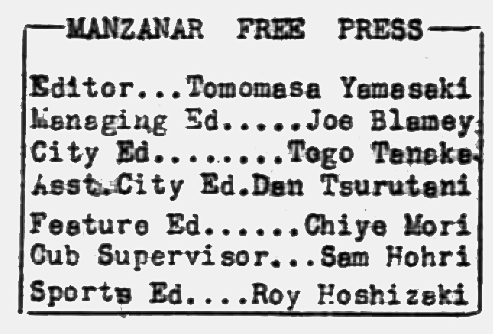 Manzanar Free Press Staff |
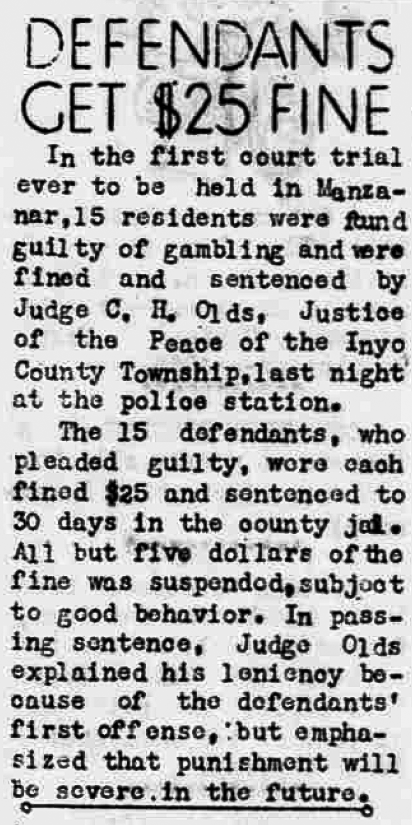 Defendants get $25 fine |
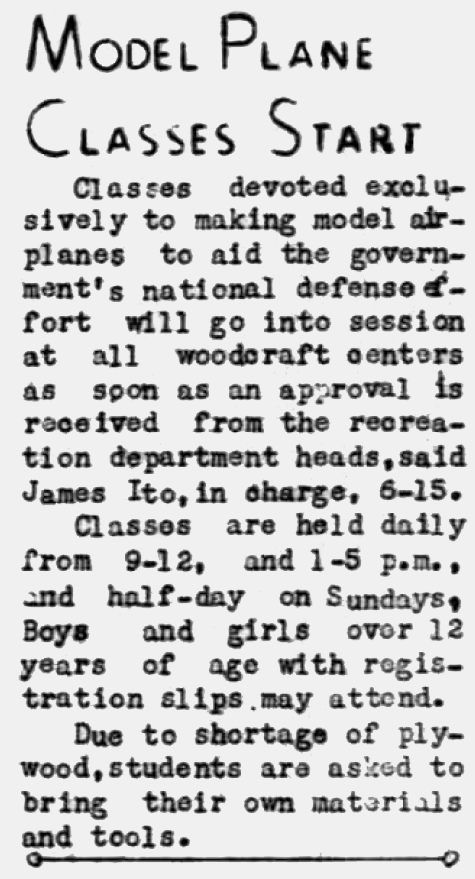 Model Plane Classes Start |
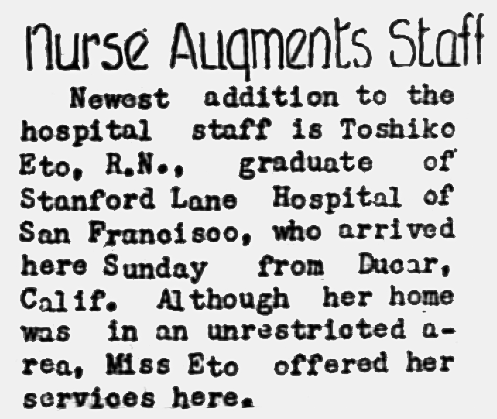 Nurse Toshiko Eto Augments Staff |
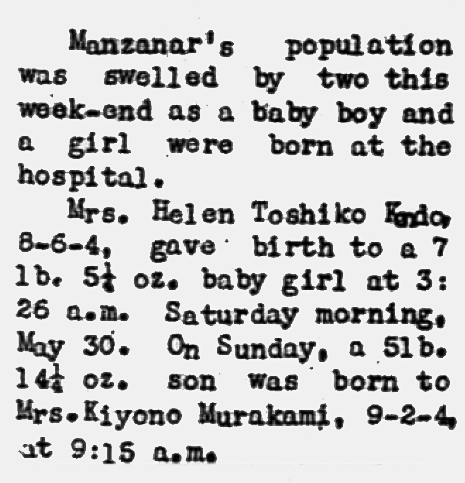 Manzanar Births |
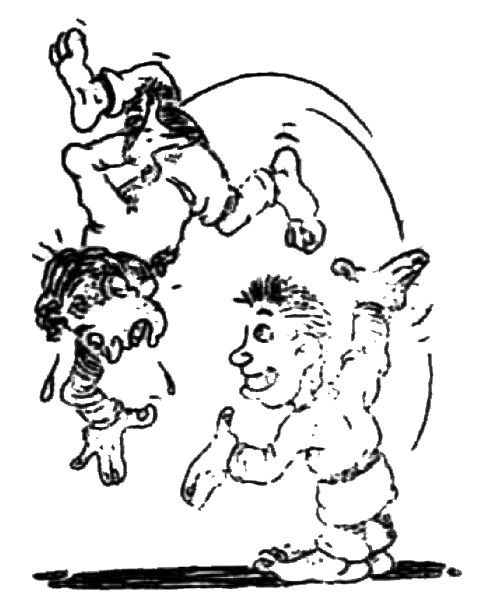 Judo Hall |
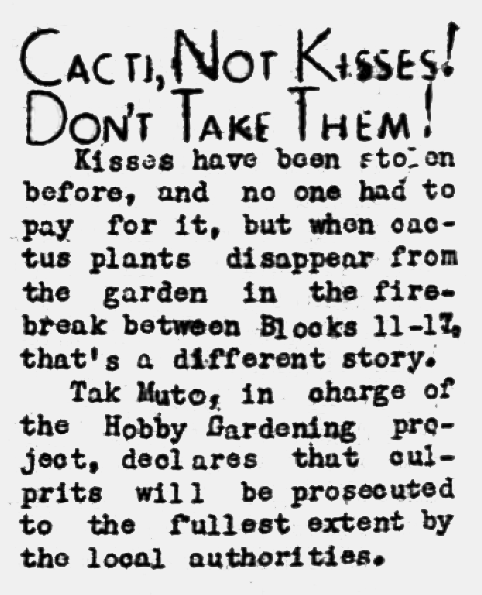 Cacti, Not Kisses! Don't Take Them! |
 Police Out to Enforce Peace — Sargeant Kiyoshi Higashi |
|
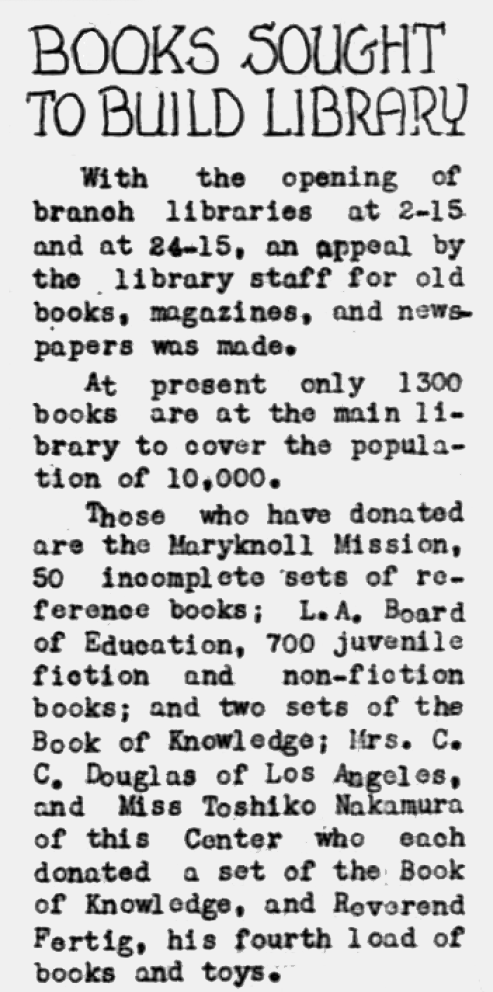 Books Sought to Build Library |
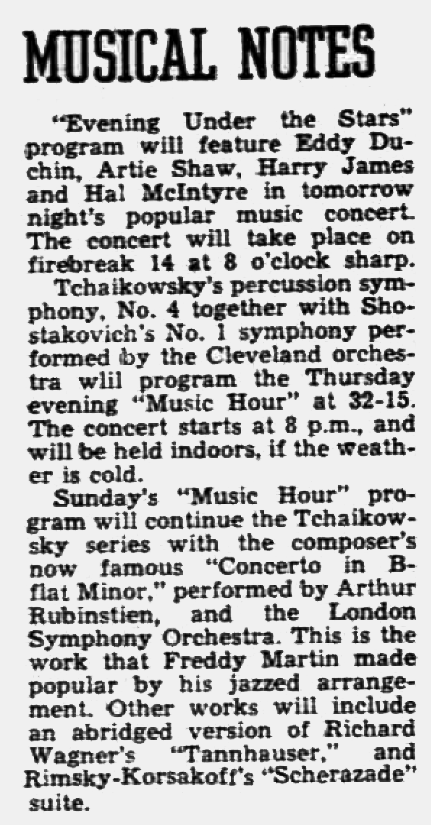 Musical Notes |
![]()
July 1942 |
 Who Dunnit? Wails Angry Chef. |
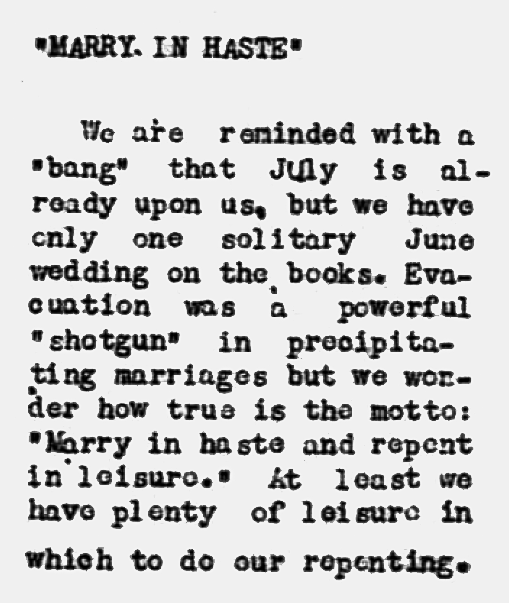 Marry in Haste |
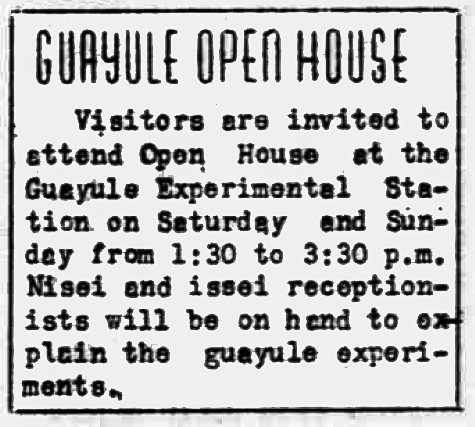 Guayule Experimental Station Open House |
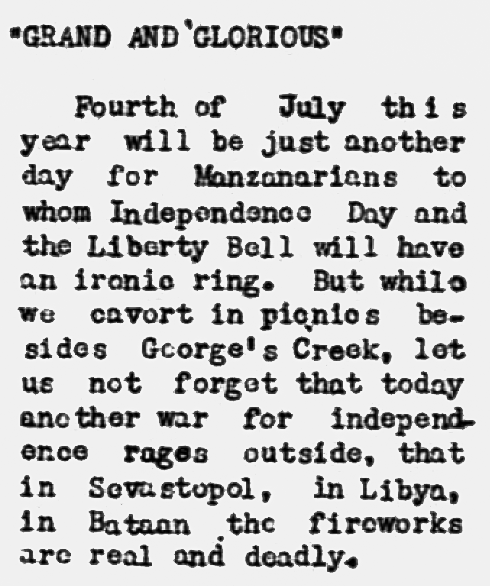 Grand and Glorious |
|
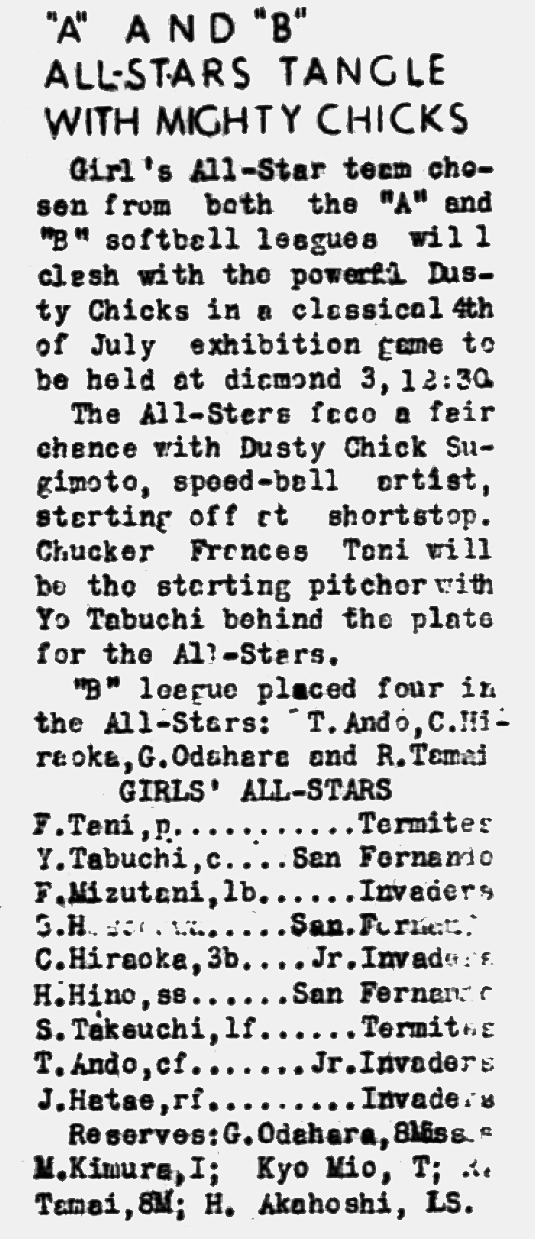 "A" and "B" All-Stars Tangle With Mighty Dusty Chicks |
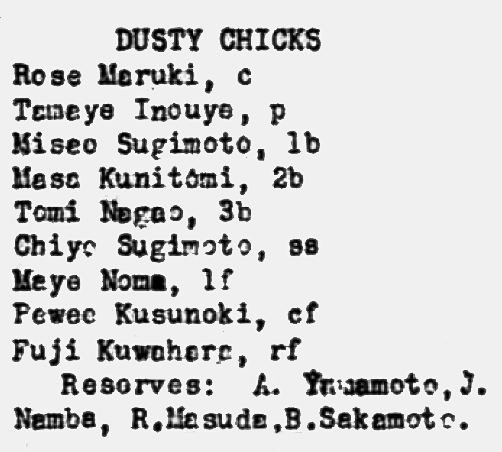 Dusty Chicks Roster |
![]()
August 1942 |
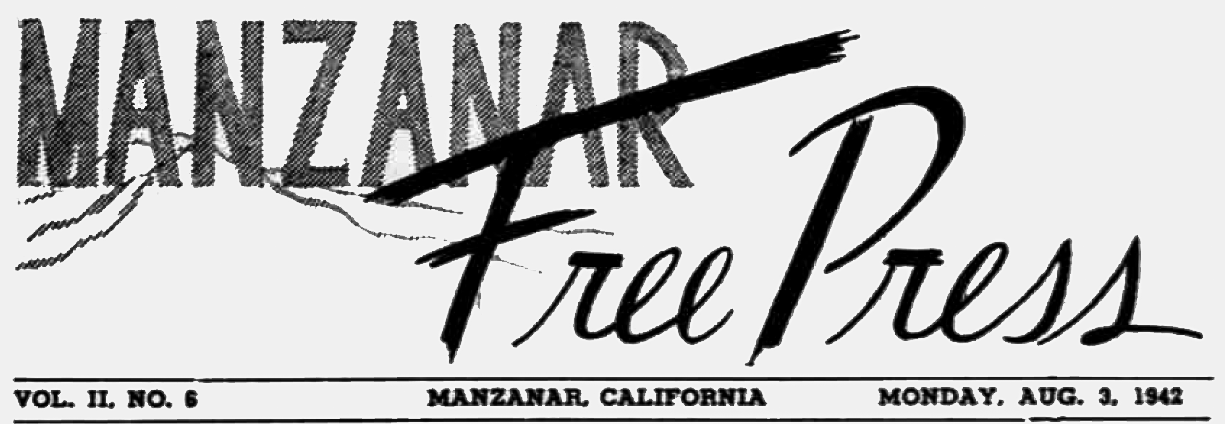 |
|
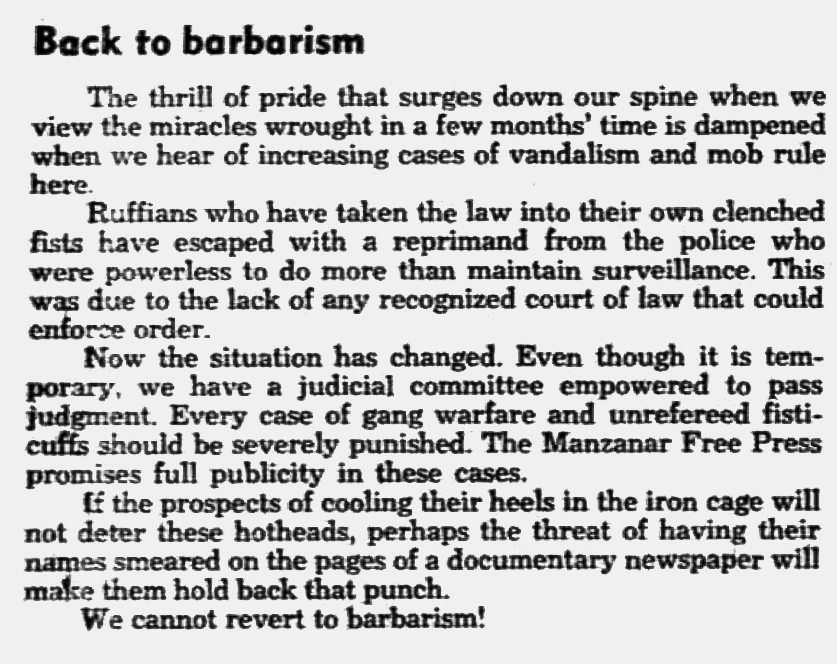 Back to Barbarism |
|
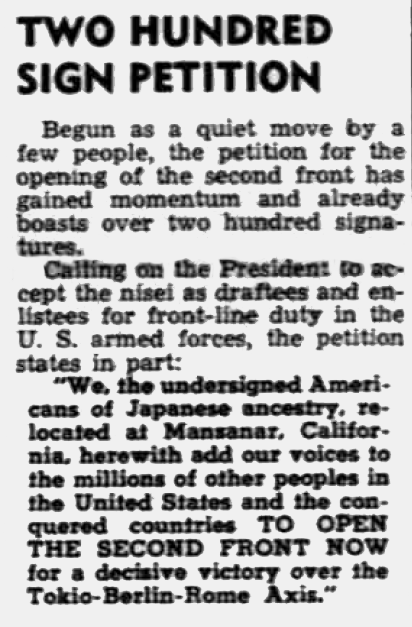 Two-Hundred Sign Petition |
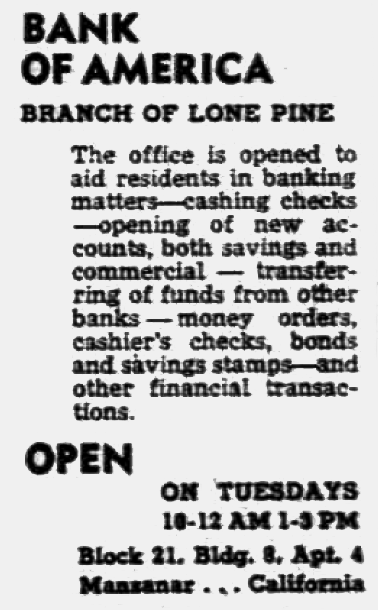 Bank of America |
Girls Lead in Camouflage Net Production |
|
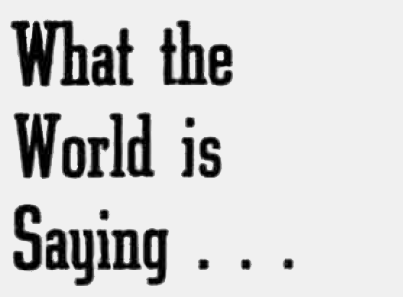 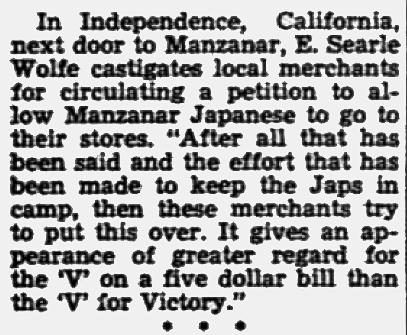 What the World is Saying in Independence, CA |
Junior Jottings "Jean and I" by Tetsuko Okumura |
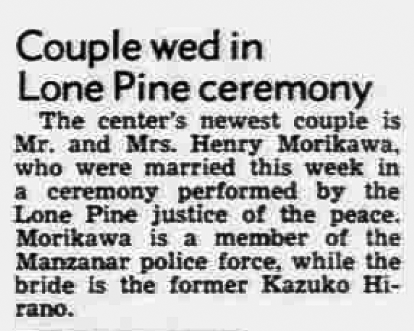 Mr. & Mrs. Henry Morikawa Wed in Lone Pine Ceremony |
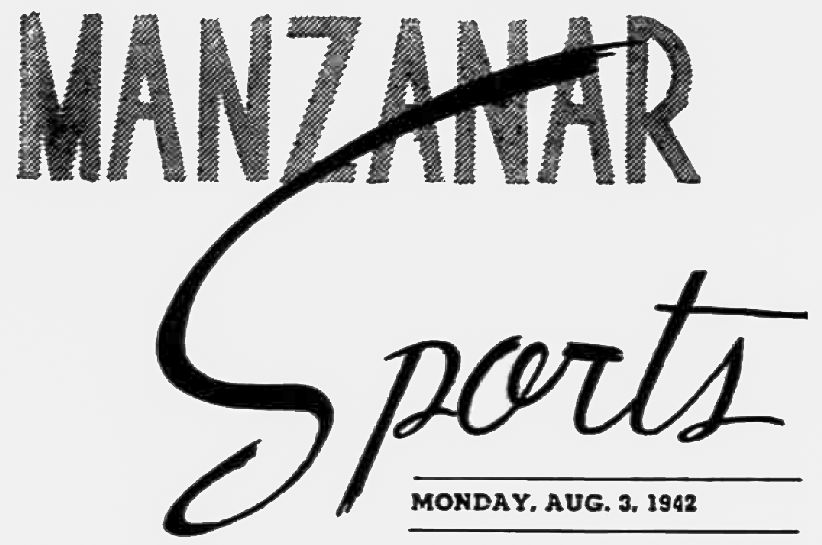 Manzanar Sports |
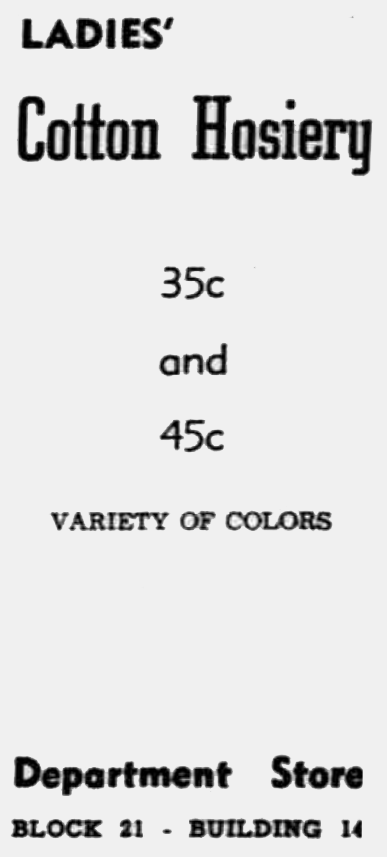 Ladies Cotton Hosiery |
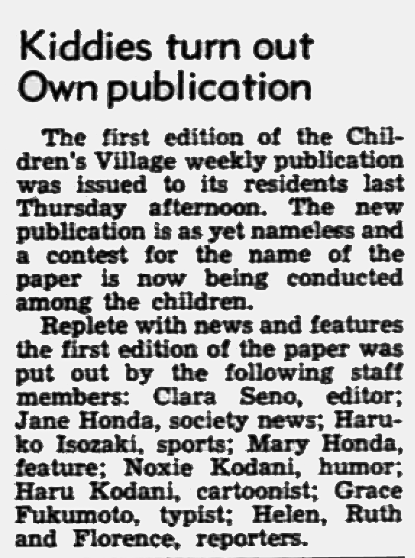 Kiddies Turn Out Own Publication Clara Seno - editor Jane Honda - society Haruko Isozaki - sports Mary Honda - feature Noxie Kodani - humor Haru Kodani - cartoonist Grace Fukumoto - typist |
 Manzanar's Major League Standings |
|
![]()
September 1942 |
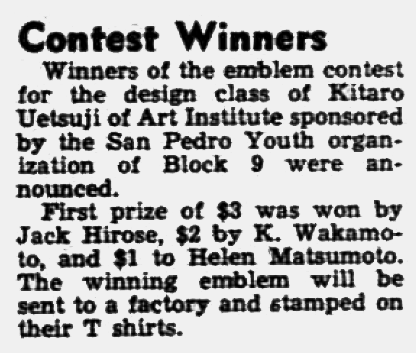 Emblem Contest Winners from Kitaro Uetsuji's Art Institute |
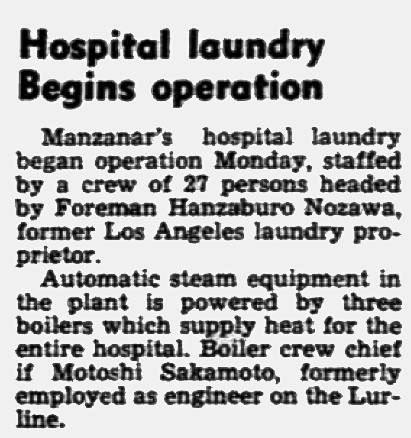 Hospital Laundry Begins Operation |
 For Women Only — Fleishers Knitting Yarn |
|
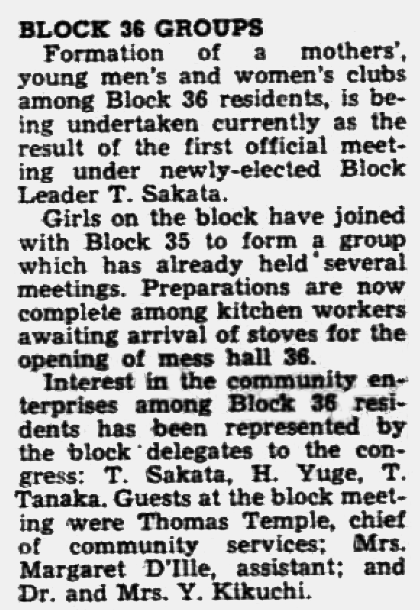 Block 36's Mother's, Young Men's, and Women's Clubs |
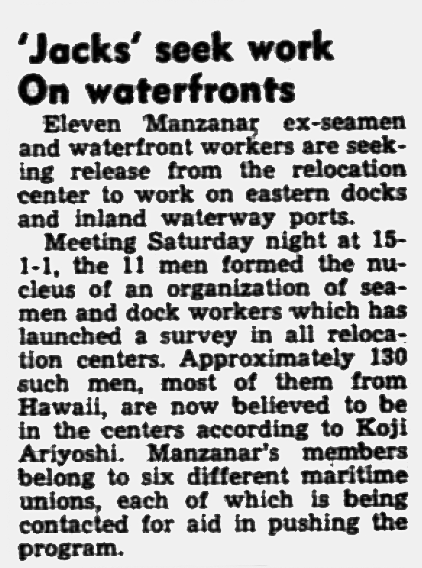 "Jacks" Seek Work on Waterfronts |
 Loomcraft Frocks |
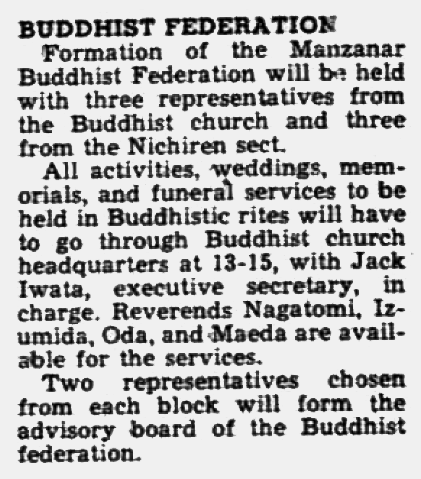 Buddhist Federation |
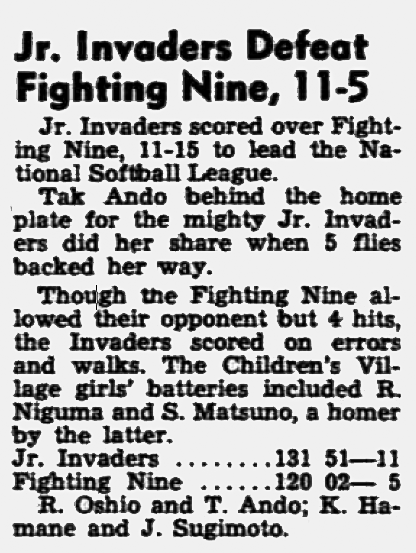 Jr. Invaders Defeat Fighting Nine, 11 - 5 |
|
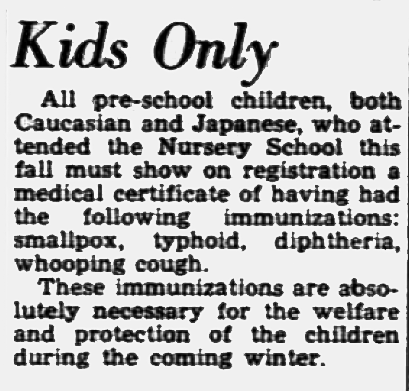 Kids Only |
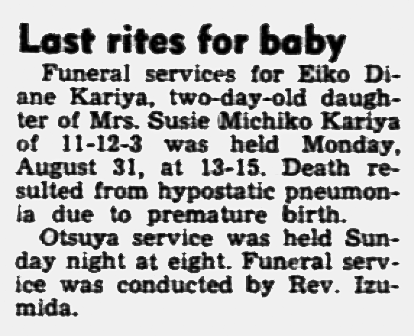 Last rites for baby Eiko Diane Kariya |
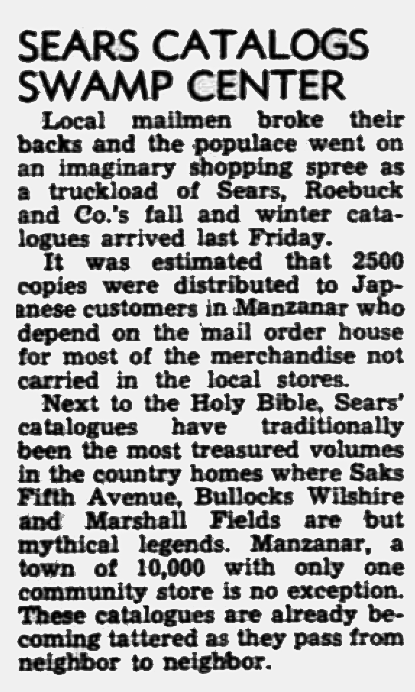 Sears Catalogs Swamp Center |
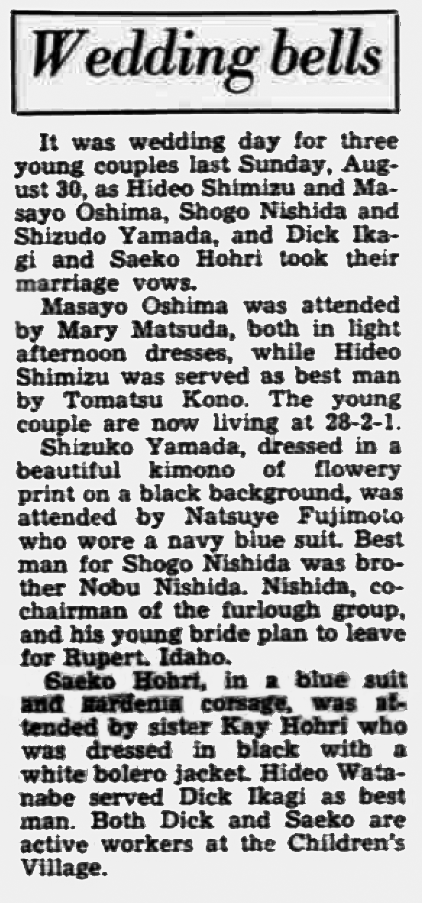 Wedding Bells for Three Young Couples |
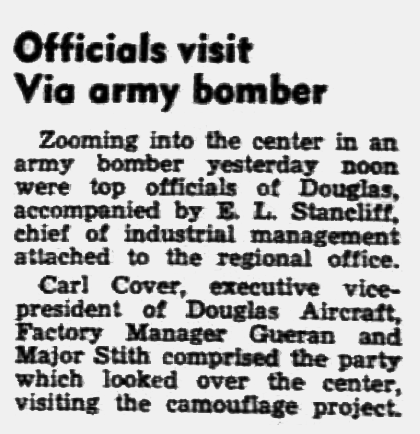 Officials Visit Via Army Bomber |
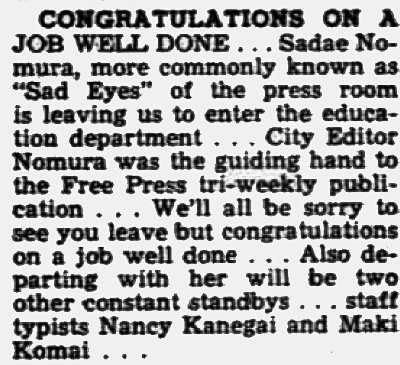 Congratulations on a Job Well Done "Sad Eyes" Sadae Nomura |
![]()
October 1942 |
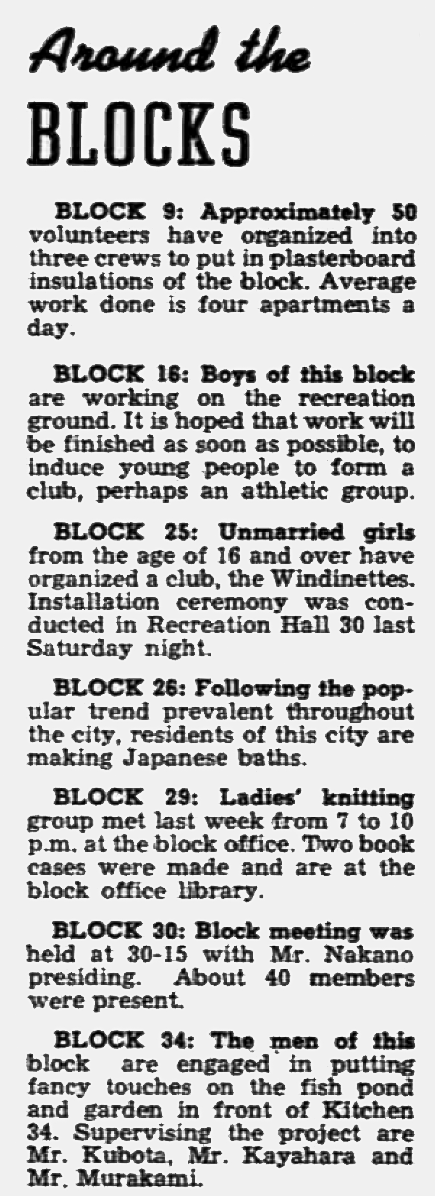 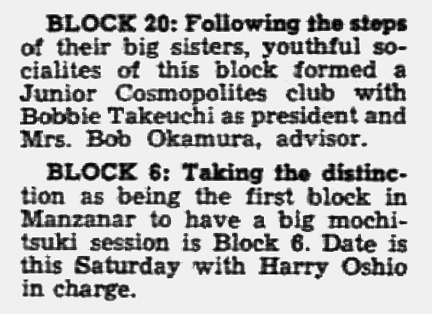 Around the Blocks — Blocks 6, 9, 16, 20, 25, 26, 29, 30, 34 |
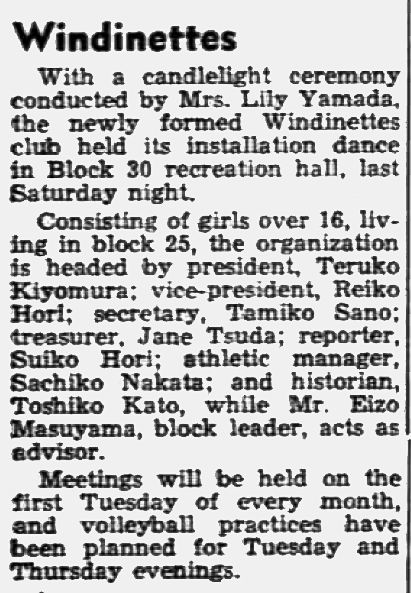 Windinettes Club Installation |
||||||
Murder - Suicide Case Finished |
|||||||
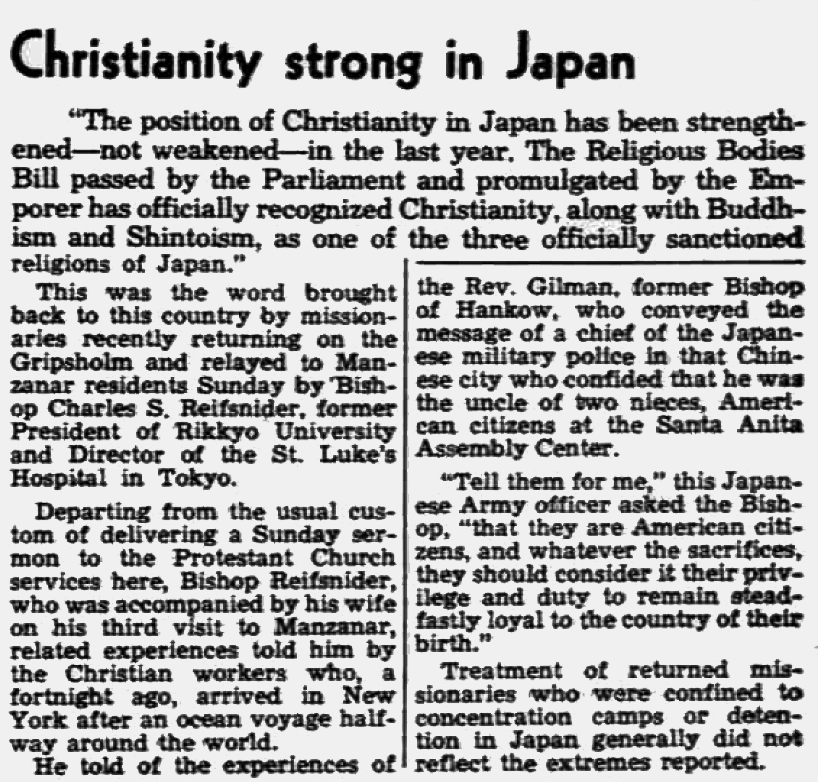 Christianity Strong in Japan |
|||||||
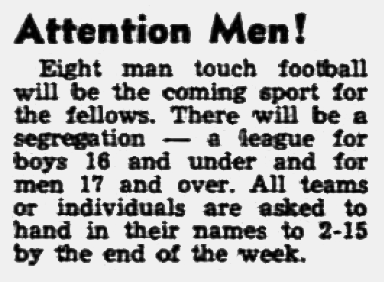 Attention Men! — Touch Football |
 Reversible Coats |
||||||
|
|||||||
![]()
November 1942 |
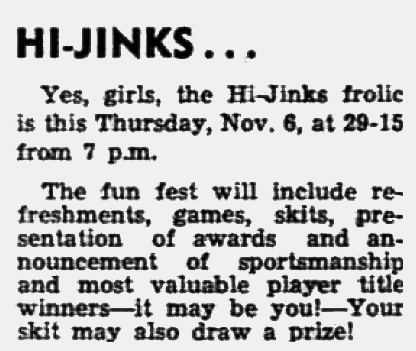 Hi-Jinks |
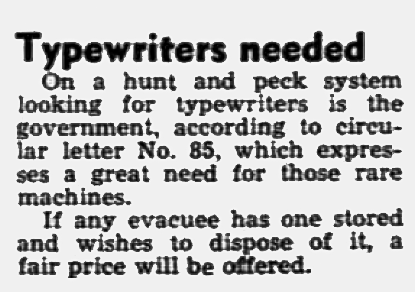 Typewriters needed |
 "I Love Coffee" |
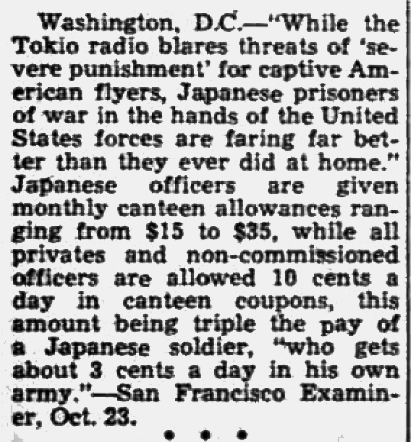 Threats of severe punishment for captive American flyers. |
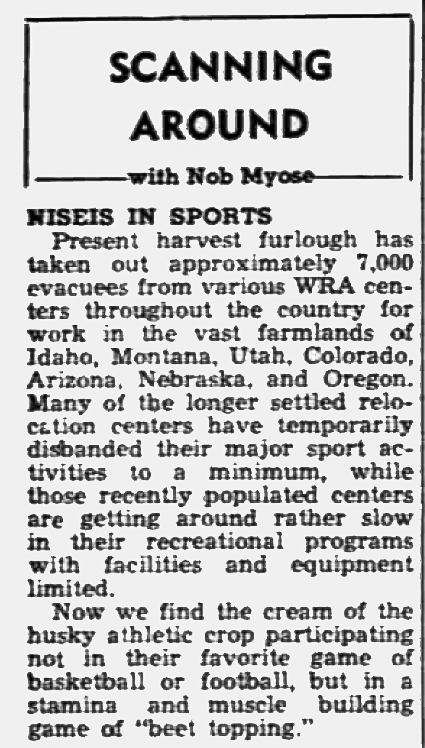 Scanning Around — Niseis in Sports |
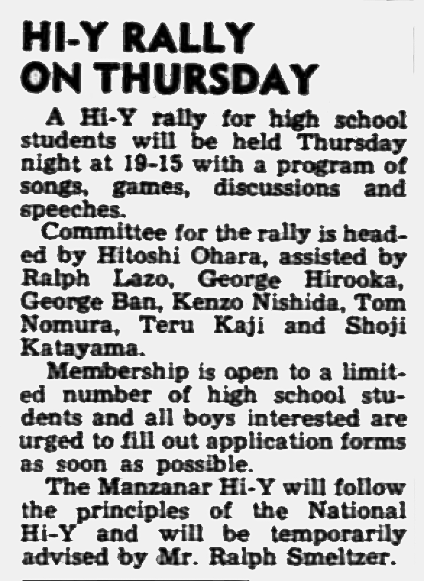 Hitoshi Ohara Announces Hi-Y Rally on Thursday |
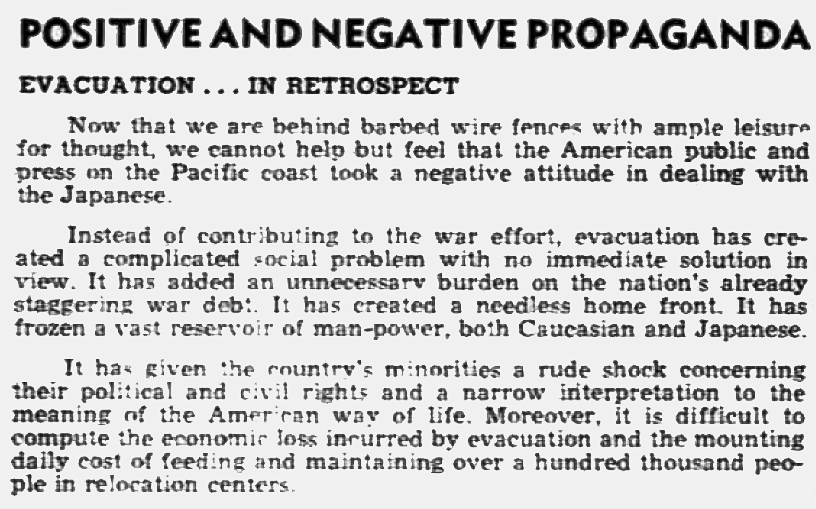 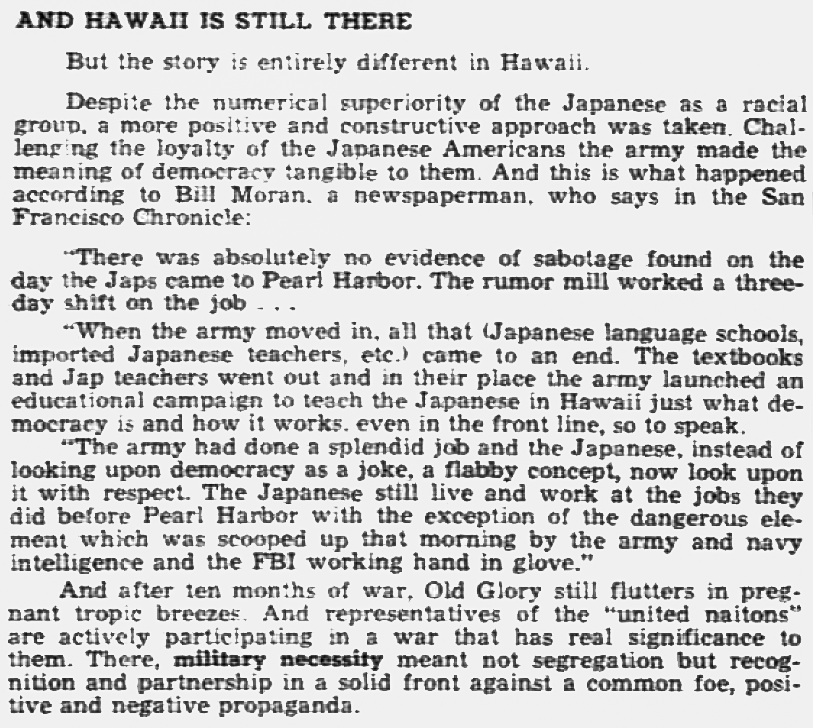 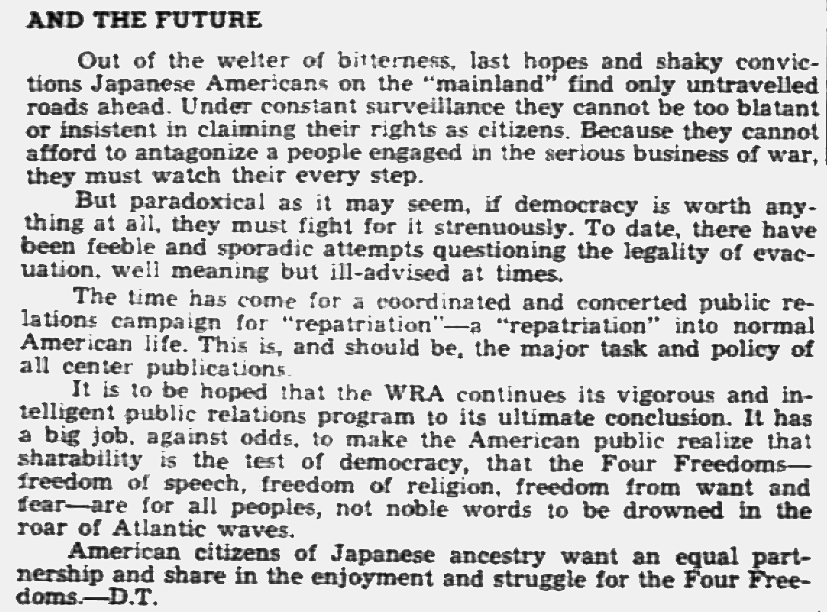 Positive and Negative Propaganda |
|
![]()
December 1942 |
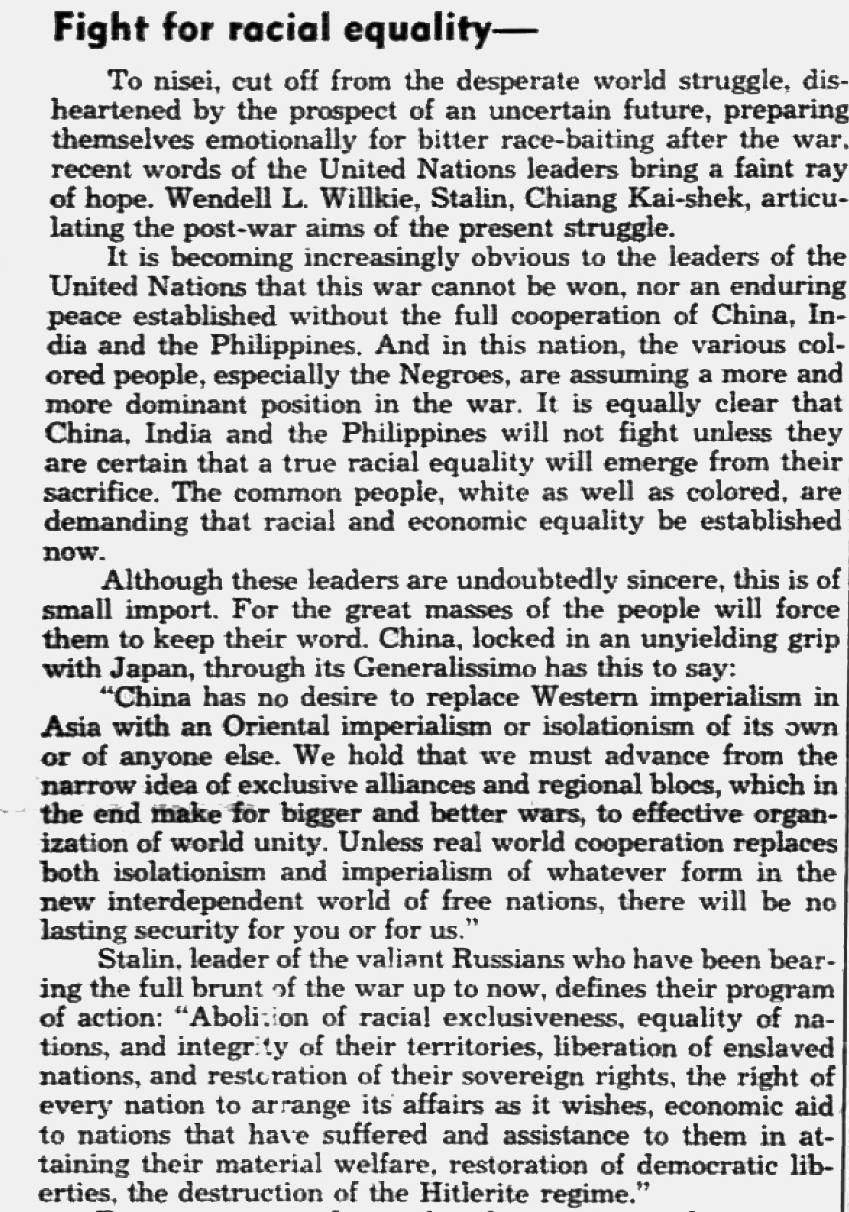 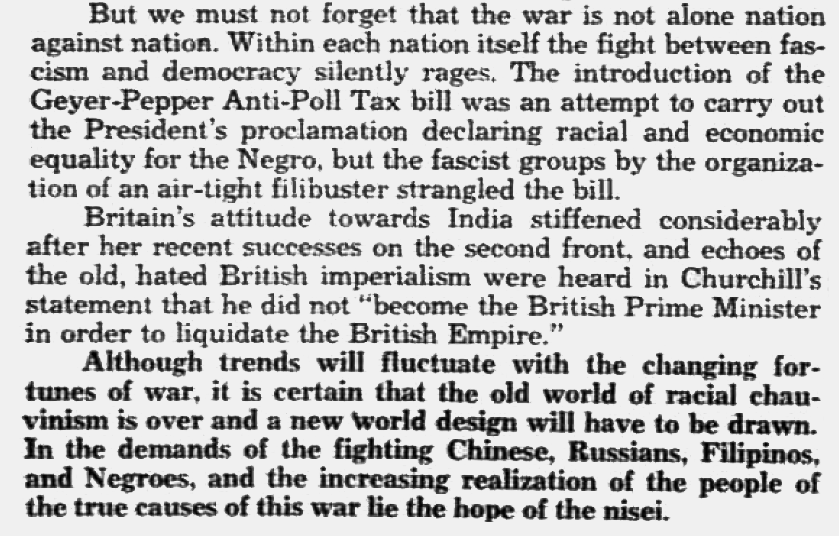 Fight for Racial Equality — |
||||
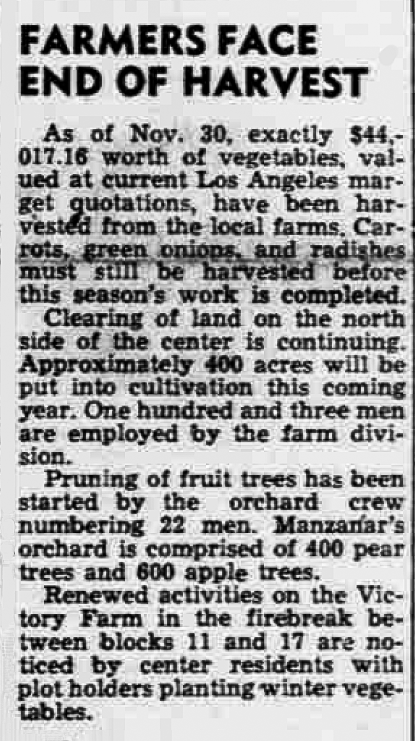 Farmers Face End of Harvest |
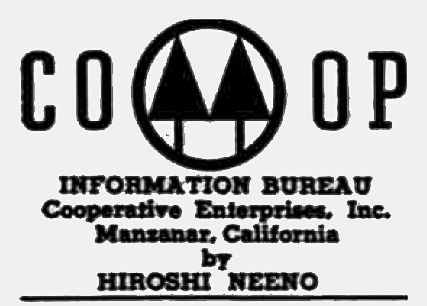 Co-Op by Hiroshi Neeno |
|||
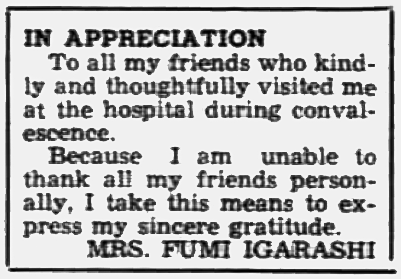 In Appreciation by Mrs. Fumi Igarashi |
||||
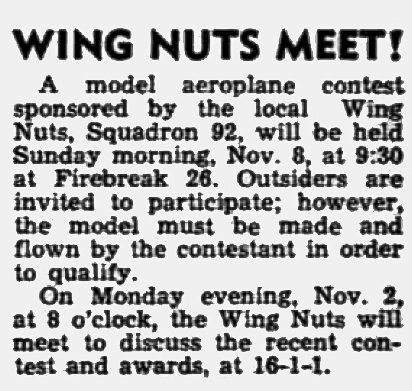 Wing Nuts Meet! — Model Aeroplane Contest |
||||
|
||||
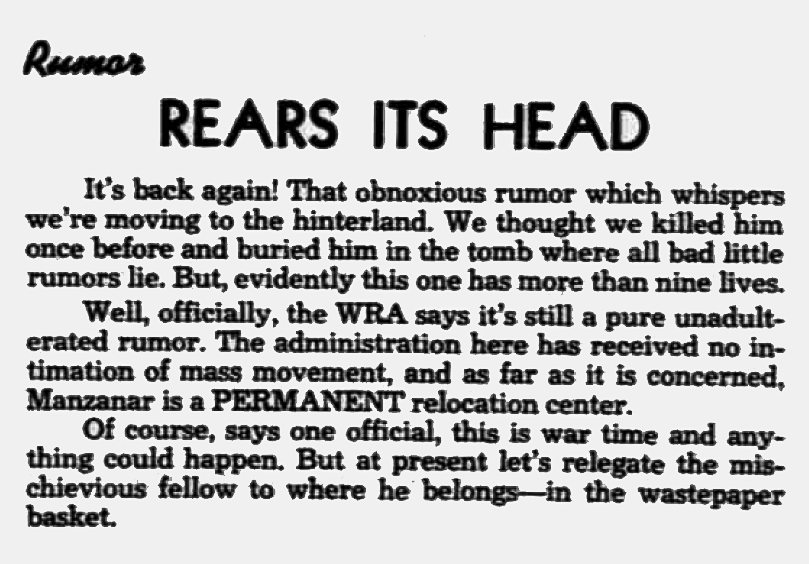 Moving Rumor Rears Its Head — WRA says Manzanar is a Permanent Relocation Center |
||||
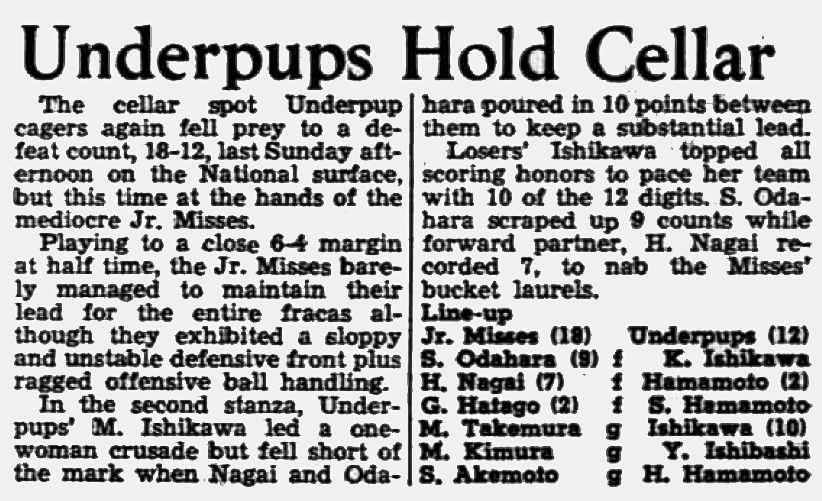 Underpup Cagers Hold Cellar |
||||
![]()
![]()
![]()
![]()
Sign Guestbook View Old Guest Book Entries Oct 1999 - Feb 2015 (MS Word) |
 CONTACT the Pigmy Packer |
View Guestbook View Old Guest Book Entries Oct 1999 - Feb 2015 (PDF) |
